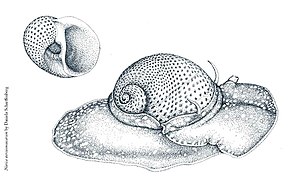Millennial moon snail
| Millennial moon snail | ||||||||||||
|---|---|---|---|---|---|---|---|---|---|---|---|---|

Drawing by Natica stercusmuscarum |
||||||||||||
| Systematics | ||||||||||||
|
||||||||||||
| Scientific name | ||||||||||||
| Natica stercusmuscarum | ||||||||||||
| ( Gmelin , 1791) |
The naticarius stercusmuscarum or thousand point umbilical screw ( Natica stercusmuscarum ) is a screw from the family of the moon screw extending from molluscs fed. It lives in the Mediterranean and adjacent areas of the Atlantic .
features
The egg-shaped-spherical snail shell of Natica stercusmuscarum , which in adult snails with 6 strongly arched whorls up to 3.7 cm in length and up to 5.3 cm in diameter, has a smooth surface and is slightly concave just below the seam. The umbilicus, which gradually merges into the surrounding housing, is large and has a thin, cylindrical, spiral-shaped bulge in the middle, which is separated from the thick inner lip by a slight indentation. The spindle lip is slightly convex. The yellowish white surface of the house is covered with dense little red dots that merge into bluish tones. There is a slightly dotted shape as well as other shapes with additional larger brown spots that can be disordered or in three rows. The umbilicus is pale reddish brown and the outside is surrounded by a narrow white band. The interior of the house is purple and white towards the mouth, the inner lip milky white. The operculum of the millennial moon snail is horny and outwardly chalky with numerous concentric, thin, granular and notched lamellae.
The mesopodium and propodium of the snail surround the snail shell with the same width when crawling. Snails of the typical color variant have white dots on their dark gray mesopodium and a white line on the edge, while snails with less dotted shells have thin whitish lines on the mesopodium and no line on the edge. The antennae and the propodium are generally whitish gray. The animal cannot completely cover its housing with its foot, only the lower edge is covered when crawling.
Distribution and way of life
The millennial moon snail occurs in the Mediterranean Sea . There it is very common on sandy and muddy soils. It lives below the intertidal zone at depths of 20 to 100 meters. Like other moon snails feed on Natica stercusmuscarum of clams and snails . The prey is grasped with the foot and a hole is drilled in the shell with the radula .
Systematics
In 1791, Johann Friedrich Gmelin describes the species under the name Nerita Stercus muscarum in his extended edition of the Systema Naturae taken over by Carl von Linné , so, like Linnaeus, summarizes the umbilical snails with the barnacles in one genus Nerita . He asks whether it is a different species from Nerita canrena (today: Naticarius canrena ). Another synonym is Natica millepunctata Lamarck , 1822.
literature
- Betty Jean Piech: Naticidae and Personidae: A Classification of Recent Species . Delaware Museum of Natural History, Wilmington, DE 1998, 60 pp.
Individual evidence
- ↑ Rodolfo Amando Philippi: The genera Natica and Amaura . Systematic Conchylia Cabinet. Nuremberg, 1852. p. 9. No. 3. Natica stercus muscarum (Nerita). Gm .
- ^ Johann Friedrich Gmelin (1791): Systema naturae per regna tria naturae secundum classes, ordines, genera, species, cum characteribus, differentiis, synonymis, locis, Caroli a Linné , p. 3669, genus 329: Nerita, p. 3673, species 11: N. Stercus muscarum. 11. N. testa laevi nivea maculis punctisque subtilissimis rufis varia; umbilico gibbo bifido. Chemn. Conch. 5th t. 187. f. 1894. Habitat in mari mediterraneo et americano, an vere distincta a canrena species?
- ↑ World Register of Marine Species , World Marine Mollusca database: Natica stercusmuscarum (Gmelin, 1791)
Web links
- Fischhaus Zepkow: Family Naticidae - moon snails
- Thomas Huelsken, Carina Marek, Stefan Schreiber, Iris Schmidt, Michael Hollmann (2008): The Naticidae (Mollusca: Gastropoda) of Giglio Island (Tuscany, Italy): Shell characters, live animals, and a molecular analysis of egg masses (PDF; 1.2 MB) . Zootaxa 1770: 1-40 (2008). Naticarius stercusmuscarum , p. 19ff.
- Naticidae , p. 598ff. Naticarius stercusmuscarum (Gmelin, 1791) , p. 603 (French, on the FAO website). JM Gaillard: Gasteropodes (p. 514ff.). From: W. Fischer, M. Schneider, M.-L. Bauchot: Guide FAO d'Identification des Espèces pour les Besoins de la Pêche. Mediterranée et Mer Noire . Organization des Nations Unies pour l'Alimentation et l'Agriculture, Rome, 1987.